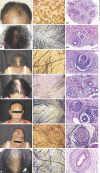Fibrosing Alopecia in a Pattern Distribution (FAPD) in 16 African-Descent and Hispanic Female Patients: A Challenging Diagnosis
- PMID: 31367598
- PMCID: PMC6615333
- DOI: 10.1159/000496837
Fibrosing Alopecia in a Pattern Distribution (FAPD) in 16 African-Descent and Hispanic Female Patients: A Challenging Diagnosis
Abstract
Background: Fibrosing alopecia in a pattern distribution (FAPD) has only been described in Caucasian patients, and it is not clear whether it can develop in dark-skin ethnicities.
Materials and methods: Sixteen Brazilian female patients, 12 of African descent and 4 Hispanic, with progressive scarring alopecia in a pattern distribution were analyzed.
Results: Dermatoscopic features showed perifollicular erythema and scaling (14/16), hair fiber diameter diversity (16/16), loss of follicular ostia (16/16), and follicular keratosis (3/16). Late stages showed a honeycomb pigmented network (12/16), a hyperpigmented perifollicular halo (12/16), and small white patches (12/16). Histopathological features showed lichenoid perifollicular infiltrate (14/16), follicular miniaturization (16/16), concentric fibrosis (16/16), perifollicular lymphocytic infiltrate (16/16), and vellus hair involvement (10/16). Premature desquamation of the inner root sheath was found in 11 patients.
Conclusions: The concomitant findings of cicatricial pattern hair loss (with or without the recess of the front hair line), hair fiber diversity, perifollicular erythema and scaling, a whitish perifollicular halo, and histological findings of androgenetic alopecia, with vacuolar interface alteration of the upper portion of the follicular epithelium, are the main key features to suggest the diagnosis of FAPD. FAPD is a possible diagnosis in patients of color with cicatricial pattern hair loss. Clinical, dermatoscopic, and histopathological examination allow a proper final differential diagnosis.
Keywords: Androgenetic alopecia; Cicatricial alopecia; Female alopecia; Fibrosing alopecia in a pattern distribution.
Conflict of interest statement
The authors declare that they have no conflicts of interest to disclose.
Figures

Similar articles
-
Case Series of Frontal Fibrosing Alopecia and Fibrosing Alopecia in a Pattern Distribution: Is There a Familial Correlation?Skin Appendage Disord. 2023 Jun;9(3):230-234. doi: 10.1159/000529923. Epub 2023 Mar 30. Skin Appendage Disord. 2023. PMID: 37325284 Free PMC article.
-
Clinicopathological characteristics of fibrosing alopecia in a pattern distribution: a single-center, retrospective study.Int J Dermatol. 2023 Nov;62(11):1391-1396. doi: 10.1111/ijd.16860. Epub 2023 Sep 28. Int J Dermatol. 2023. PMID: 37766670
-
Clinicopathological characteristics and treatment outcomes of fibrosing alopecia in a pattern distribution: A retrospective cohort study.J Eur Acad Dermatol Venereol. 2021 Dec;35(12):2440-2447. doi: 10.1111/jdv.17604. Epub 2021 Sep 28. J Eur Acad Dermatol Venereol. 2021. PMID: 34415628
-
Fibrosing alopecia in a pattern distribution.J Am Acad Dermatol. 2021 Dec;85(6):1557-1564. doi: 10.1016/j.jaad.2019.12.056. Epub 2020 Jan 8. J Am Acad Dermatol. 2021. PMID: 31926219 Review.
-
Frontal Fibrosing Alopecia: A Comprehensive Review with Recent Updates.Indian J Dermatol. 2025 Mar-Apr;70(2):115. doi: 10.4103/ijd.ijd_419_24. Epub 2025 Feb 27. Indian J Dermatol. 2025. PMID: 40162350 Free PMC article. Review.
Cited by
-
Case Series of Frontal Fibrosing Alopecia and Fibrosing Alopecia in a Pattern Distribution: Is There a Familial Correlation?Skin Appendage Disord. 2023 Jun;9(3):230-234. doi: 10.1159/000529923. Epub 2023 Mar 30. Skin Appendage Disord. 2023. PMID: 37325284 Free PMC article.
-
Pruritus in Lichen Planopilaris and Frontal Fibrosing Alopecia-Clinical Characteristics and Dermoscopic Correlations.J Clin Med. 2024 Aug 19;13(16):4898. doi: 10.3390/jcm13164898. J Clin Med. 2024. PMID: 39201040 Free PMC article.
-
Androgenetic Alopecia or Fibrosing Alopecia in a Pattern Distribution: When to Perform Biopsy in Unusual Cases?Indian J Dermatol. 2022 Jan-Feb;67(1):90-91. doi: 10.4103/ijd.ijd_381_21. Indian J Dermatol. 2022. PMID: 35656261 Free PMC article. No abstract available.
-
Trichoscopy for the Hair Transplant Surgeon-Assessing for Mimickers of Androgenetic Alopecia and Preoperative Evaluation of Donor Site Area.Indian J Plast Surg. 2021 Dec 20;54(4):393-398. doi: 10.1055/s-0041-1739245. eCollection 2021 Oct. Indian J Plast Surg. 2021. PMID: 34984075 Free PMC article. Review.
-
Comment on Follicular Inflammation and Fibrosis in Pattern Hair Loss.Skin Appendage Disord. 2021 Feb;7(2):159-160. doi: 10.1159/000513089. Epub 2021 Feb 8. Skin Appendage Disord. 2021. PMID: 33796566 Free PMC article. No abstract available.
References
-
- Zinkernagel MS, Trüeb RM. Fibrosing alopecia in a pattern distribution: patterned lichen planopilaris or androgenetic alopecia with a lichenoid tissue reaction pattern? Arch Dermatol. 2000 Feb;136((2)):205–11. - PubMed
-
- Sperling L, Cowper S, Knopp E. Informa healthcare. 2012. An atlas of hair pathology with clinical correlations USA T&F, editor.
-
- Mardones F, Hott K, Martinez MC. Clinical study of fibrosing alopecia in a pattern distribution in a Latin American population. Int J Dermatol. 2018 Feb;57((2)):e12–4. - PubMed
-
- Olsen EA. Female pattern hair loss and its relationship to permanent/cicatricial alopecia: a new perspective. J Investig Dermatol Symp Proc. 2005 Dec;10((3)):217–21. - PubMed
LinkOut - more resources
Full Text Sources

